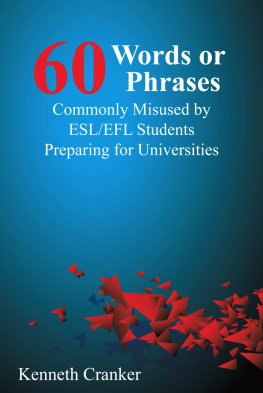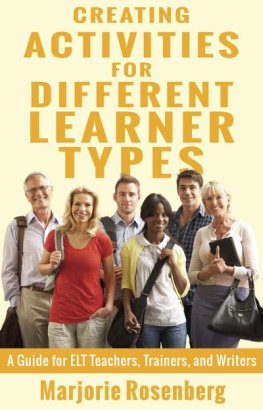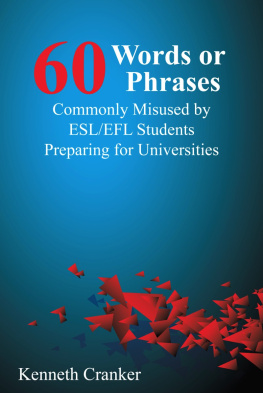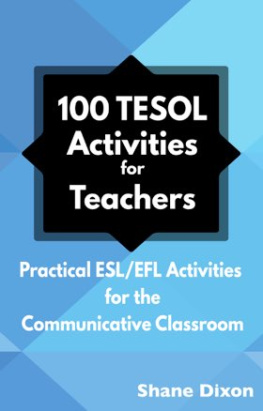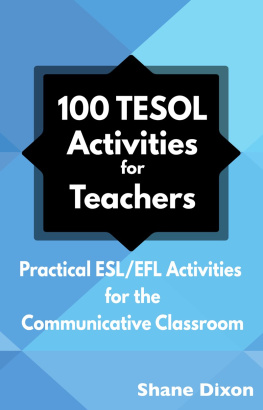Fifty Ways to Teach Speaking
Janine Sepulveda
50 Ways to Teach Speaking: Tips for ESL/EFL Teachers
Copyright 2012 by Janine Sepulveda; revised 2019
All rights reserved. No part of this publication may be reproduced, stored in or introduced into a retrieval system, or transmitted, in any form, or by any means (electronic, mechanical, photocopying, recording, or otherwise) without the prior written permission of the copyright owner. Dramatic works contained within this volume are intended only as reading material, and their inclusion does not imply the granting of performance licenses, which must be arranged through the author.
Edited by Dorothy E. Zemach. Cover design by DJ Rogers.
Published in the United States by Wayzgoose Press.
How To Use This Book
Most teachers use a textbook in class, which provides both instruction and practice but, often, not enough practice. Students need to practice again and again, and in different ways, not just to keep their interest but to both learn and remember.
This book gives you ideas to help your students practice speaking in English. It can be used with any textbook, or without any textbook at all. It tells you how to adapt and extend exercises; it gives you games and warm-ups that can be added to any class; it gives you methods to practice both accuracy and fluency.
Not every idea will work for every student or for every class. Thats why there are fifty. We feel sure that many of the ideas presented here will bring you results if you try them sincerely and practice them regularly.
Here is a suggested method for using this book:
- Read through all of the fifty tips without stopping.
- Read through the tips again. Choose five or six that you think might work for your class. Decide when you will try them.
- Choose different types of ideas: Some that can be done independently, and some that work along with your textbook; some that focus on pronunciation, and some that focus on grammar or vocabulary.
- Each time you use one of the ways, make a note about how well it worked for you and why. Remember that most of the tips will work best if you use them several times (or even make them a habit). Dont try a tip only once and decide its no good for your students. Give the tips you try a few chances, at least.
- Every few weeks, read through the tips again, and choose some new ones. Discontinue using any methods that are not working for you.
Finally, consider trying some of the other books in our 50 Ways to Teach series. No one skill in English is really separate from the others. Speaking, listening, reading, writing, vocabulary, and grammar are all connected. Students who improve in one area will almost always improve in other areas too. The series also includes special volumes for teaching pronunciation, young learners, teenagers, and for using technology in the classroom.
Introduction
This book is for teachers who are new to ESL/EFL, or teachers who are looking for more interactive activities for their English classes. This isnt an exploration of research and pedagogy, but a list of speaking activities and tips for making activities more effective. Many of the ideas are based on a communicative language teaching approach.
Not all these ways may work for your class exactly as written. However, it is always a good idea to look at an idea and think about how you could adapt it to fit your own context. When you read a tip, think about how you could change it to fit your students ages, levels, culture, and interests. Please feel free to adapt the activities in any way you like.
This book is divided into 6 categories:
- Ice breakers
- Warm-ups/fillers/games
- Fluency
- Integrated skills
- Focused practice activities
- Tips to make activities more effective
Drills and memorization are useful in language learning, but students also need opportunities for real and meaningful communication. Most of these tips focus on giving students opportunities to communicate ideas, opinions, or information to others. Some activities focus solely on fluency development. However, there are also activities that focus on specific skills such as stress, intonation and prosody, pronunciation, vocabulary enrichment, and target grammatical structures, among others.
Building a classroom community is important for successful teaching and learning. When you know your students, and they know each other, students will feel more comfortable and relaxed.
Learning a new language can be stressful. Often students are afraid to make mistakes, which impedes their ability to progress in a new language. Older students may feel like they have become children again, which is not always a comfortable feeling!
Therefore, creating an environment where students feel safe, comfortable, and respected is highly important. They should also feel free to make mistakes, as mistakes are a natural part of the learning process. This will allow them to take risks, try new things, and work on both accuracy and fluency.
The following ice-breakers are designed to help students get to know each other using English in a non-stressful way. The goal of these activities is not perfect English; it is to build classroom connections among students and have some fun while doing it!
Level: Beginning to Advanced
This activity works well with any level simply change the topic to accommodate students capabilities. However, even a linguistically simple topic can work with more advanced students as they negotiate how to form their line and learn about each other.
You can use this ice-breaker more than once with the same group, on the same day or on different days. Simply choose a new topic. Even adults enjoy this activity!
How it Works
Pick a topic. Ask students to line themselves up according to the topic you give them; for example, date or month of birth, shoe size, favorite flavor of ice cream (alphabetically), etc.
For lower-level students, write some useful language on the board and go over it before they begin, so they can have short conversations instead of just calling out numbers to each other. For example, if they are to line up by birthday, write phrases such as When were you born? September? Oh, me too! What day? OK, my birthday is before/after yours.
Level: Intermediate to Advanced
This is a fun way for students to share personal information about themselves in a game-like format that keeps everyone engaged.
It is important for the teacher to model this so that the students can understand how it works. Here is my example:
- I once met Princess Diana.
- I made a commercial for a clothing store in Egypt.
- I have lived in 10 countries.



